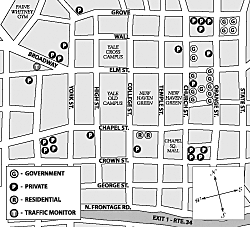

New Haven, Connecticut, is a relatively small city. It is really more of a town than a city; it's a college town, with Yale University at its heart. And yet, all things considered -- the large number of surveillance cameras in operation at universities such as New York University, the wealth and power of the parents of most Yale students, and the age and beauty of the univeristy's campus -- one might have expected that New Haven would be filled with surveillance cameras.
But it isn't: in fact, New Haven has comparatively few surveillance cameras operating in public places. On 20 February 2003, a mapmaker from the New York Surveillance Camera Players -- brought up to New Haven for the day by The New Haven Advocate, a weekly newspaper that was writing an article on the group -- spotted and mapped out a total of 40 surveillance cameras in the square-shaped area between Grove and George Streets and between State and York Streets. This number averages out to one surveillance camera per square block, which is four times less than the average in New York City.
There are comparatively few surveillance cameras in New Haven because very few private companies are using them (mostly bars) and because Yale University doesn't use any at all. The latter (and quite unexpected) fact might indicate that Yale isn't concerned for the safety of its students or has never been sued by the victim of an attack, that the university doesn't have research labs that are concerned with the commercial development of video technology, or that Yale doesn't want to damage the facades of its marvelous carved-stone buildings by installing video surveillance systems on and through them.
As a result, a whopping forty percent of the surveillance cameras in New Haven are operated by local, state or federal government authorities. Most of these 15 cameras are installed on the short, dense row of official buildings on Church Street between Chapel and Elm; the rest are installed on the unmarked FBI building on Orange Street between Wall and Grove. The camera on City Hall is especially striking: it sits atop of the building's belfry (about 12 stories up) and so can surveill a truly large area and look right into the windows of surrounding buildings. Another notable camera is the wireless one installed atop a road sign at the intersection of Whalley and Elm Streets. Unlike most surveillance cameras devoted to "traffic flow monitoring," which is evidently the purpose of this particular camera, it is globe-shaped and not shaped like a box or tube. That is to say, the mini-camera installed within this globe can pan, tilt and zoom, which are things that 1) cameras shaped like boxes or tubes can't do and 2) cameras designed to simply monitor traffic flows need not (indeed, should not) be able to do.
Usually government-operated cameras account for only ten percent of the total number of cameras in operation, with the rest operated by private companies. As we pointed out in our analysis of the Lower East Side of Manhattan, where the government/private sector ratio is also unusually high, one can use this information to predict with some confidence that -- if and when Yale University and other private companies and corporations in New Haven (finally) start operating surveillance cameras -- there will 166 cameras where today there are only 40.
(How did we arrive at this number? We multiplied the number of government cameras by 10 to get the number of private cameras that "should be" or are typically in operation in heavily surveilled areas. In New Haven's case, that "should be" number is 150. But there are actually only 24 private cameras in operation. And so we added the difference or 126 to the current total, which is 40, thus produced a "will be" total of 166.)
Such a dramatic increase in the surveillance of public places could -- if unchecked -- take place relatively quickly, that is, within the next 3 to 5 years.
--22 February 2003.
By e-mail SCP@notbored.org
By snail mail: SCP c/o NOT BORED! POB 1115, Stuyvesant Station, New York City 10009-9998